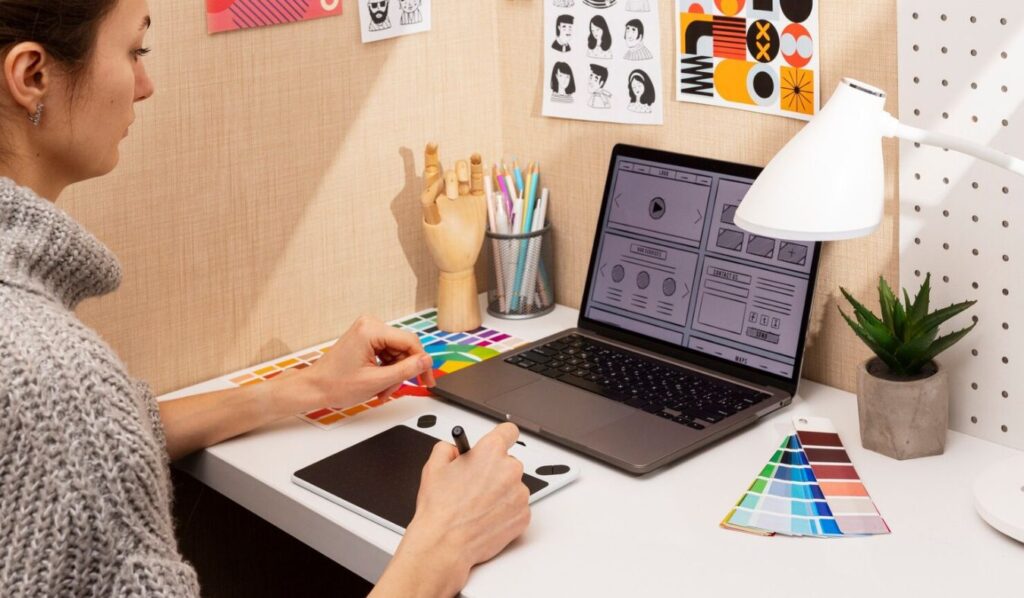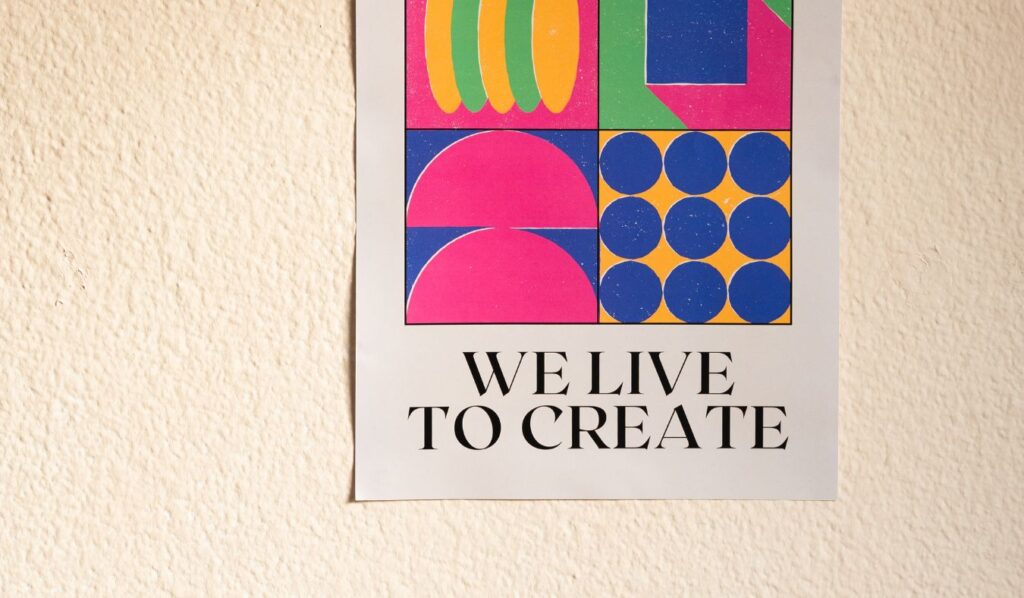Your logo is your brand’s handshake with the world. It’s often the very first impression a potential customer has – on websites, social media, business cards, and even the product itself. A great logo has immense power to influence:
- Instant Recognition: The most iconic logos are identifiable even without the company name attached (think Nike’s swoosh or Apple’s apple).
- Trust & Likeability: A well-designed logo makes your brand look polished and professional, signaling that you care about the details.
- Setting You Apart: In a crowded marketplace, a distinctive logo helps you stand out from the sea of sameness.
More Than Just a Picture
Your logo isn’t merely decoration. It subtly communicates your brand’s personality, values, and what makes you unique. Is your business playful and modern? Classic and trustworthy? Luxurious? Environmentally conscious? Your logo design should be the visual distillation of these qualities.
DIY vs. Professional
The path to the perfect logo isn’t one-size-fits-all. For some, putting in the time and effort to design their own is rewarding and budget-friendly. Others recognize that investing in a professional designer ensures a logo that is strategically sound and expertly executed.
Let’s dive into the key elements of successful logos and how to create one that truly represents your brand!
1. What is a Logo?
A logo is a graphic mark, emblem, or symbol custom-designed to represent a company, organization, product, or service.
Why Logos Matter
- Recognition: Instantly identifies your business, especially as it gains exposure.
- Differentiation: Helps you stand out from competitors in a crowded marketplace.
- Brand Message: The design choices in a logo subtly communicate your values, style, and the kind of experience customers can expect.
- Trust Building: A professional-looking logo signals quality and attention to detail.
2. Types of Logo Design
Wordmarks (or Logotypes)
- Focus on the business name itself as the visual anchor.
- Typography is key: The font chosen becomes synonymous with the brand.
- Examples: Google, Coca-Cola, FedEx.
- Best For: Businesses with strong, distinctive names that are easy to read.
Symbol or Icon Logos
- A purely graphic representation, no company name included (or used as a secondary element)
- Requires brand recognition: The symbol must become instantly identifiable (think Apple, Target, Nike).
- Flexibility: Often works well across various sizes and applications.
- Best For: Businesses with longer names or those targeting a global audience (no language translation of a symbol needed).
Combination Marks
- The most common type – blends a stylized company name with a symbol or icon.
- Versatility: The elements can be used together or separately as needed.
- Examples: Starbucks, Adidas, Lacoste.
- Best For: Newer businesses needing both name recognition and a memorable visual element.
Emblems
- Text enclosed within a shape, often resembling a badge, crest, or seal.
- Conveys tradition, heritage, authority.
- Examples: Harley-Davidson, many universities, Starbucks’ original logo
- Best For: Organizations with history or those wanting to project a sense of established authority.
Abstract Logos
- Geometric shapes or artistic concepts, not a literal representation.
- Allows for unique interpretations, can evoke emotion or curiosity.
- Requires strong branding: The logo gains meaning through consistent use and association with the company.
- Examples: Pepsi, Adidas (three stripes), BP
- Best For: Brands wanting to stand out with a visually bold and unique mark.
Important Note: These categories aren’t rigid. There’s room for overlap and creative variations tailored to a specific business or industry.
3. Key Elements of Effective Logo Design
Simplicity
- Uncluttered Power: The most iconic logos are often deceptively simple. Stripping away excess detail aids memory.
- Clarity & Impact: Simplicity ensures the message is clear at a glance, without distractions. This is vital in a world full of visual noise.
- Easy Reproduction: Complex logos become expensive or illegible to print at small sizes or embroider, etc.
Scalability
- Size Matters: From the tiny favicon on a browser tab to a giant billboard ad, your logo must work at all scales.
- Detail vs. Impact: Overly intricate designs lose clarity when shrunk and become muddy when enlarged.
- Adaptability: A scalable logo means you won’t have to create drastically different versions for various applications, saving time and money.
Versatility
- Black & White First: If your logo looks great in black and white, it forms strong foundation to build color versions upon.
- Background Independence: It should pop against both light and dark backgrounds, various textures, etc.
- Contextual Success: Think beyond the website – how will the logo look on merchandise, vehicles, temporary signage…
Relevance
- Target Audience Alignment: A playful logo with bright colors won’t resonate with clients of a serious law firm and vice-versa.
- Industry Cues: Subtle visual nods to your industry help establish instant understanding (a coffee bean shape for a cafe, etc.).
- Competitive Landscape: Your logo should differentiate you, not copy common tropes within your market.
Timelessness
- Trendy vs. Enduring: Chasing the latest design fad means your logo will quickly look dated, necessitating costly rebrands.
- Classic Foundations: Strong typography, clean shapes, and a well-chosen color palette can age gracefully for decades.
- Room for Growth: Your business may evolve, but a timeless logo provides a stable anchor for those changes.
4. The Logo Design Process
Designing an effective logo is an iterative journey, not a sprint. Following this process increases your odds of creating something you’ll be proud of for years to come.
Brand Discovery
- Who Are You, Really?: Before sketching, define your company’s mission, core values, and what makes you different.
- Ideal Customer: Who do you want to attract? Your logo needs to resonate with them, not just your own personal taste.
- Words Matter: Brainstorm a list of words that describe your brand personality (modern, playful, luxurious, eco-conscious, etc.).
Research & Inspiration
- Competitor Analysis: What are others in your industry doing? Identify gaps to fill or overused tropes to avoid for differentiation.
- Mood Boards: Collect images, colors, fonts…anything that evokes the feeling you want your brand to evoke. Pinterest is great for this.
- Analyze Success: Look at logos you admire. What makes them work for their specific brand? Don’t just copy aesthetics without context.
Sketching
- Embrace Quantity: Don’t overthink early sketches. Crude doodles are fine – get lots of ideas down loosely to spark unexpected directions.
- Wordplay: If your company name is part of the design, experiment with different typefaces and arrangements.
- Symbol Exploration: Even if not sure you’ll use one, play with simple shapes or concepts related to your industry for inspiration.
Digital Iterations
- Choose Your Tools: Software ranges from free and beginner-friendly (Canva) to complex pro tools (Adobe Illustrator).
- Refine & Explore: Select your strongest sketches and build upon them. Try variations in color, line weight, etc.
- Don’t Get Attached: It’s easy to fall in love with your early work. Be open to feedback that leads to a better final outcome.
Feedback
- Target Audience is Key: Show logo options to people who fit your ideal customer profile, not just those who know you personally.
- Specific Questions: Ask about clarity, memorability, and whether it aligns with how you WISH your brand to be perceived.
- Honest & Objective: Getting overly defensive of your designs hinders the process. Remember your ego is not your brand.
Finalize & Variations
- Black & White First: If it works in monochrome, color will only enhance it.
- Stacked & Horizontal: Think about how your logo will be used on various layouts.
- Icon Only (if applicable): This may be needed for social media profile images, etc.
5. DIY Logo Design Tools & Resources
If you’re bootstrapping or simply enjoy the creative challenge, tackling your own logo design is achievable. Here are tools to get you started:
Free Design Software
- Canva: User-friendly, template heavy. Good for simple logos, less so for complex custom designs.
- Vectr: Free vector-based graphics program (similar to Adobe Illustrator). Steeper learning curve, but more power for fine-tuning.
- Others: Inkscape, GIMP, etc. Vary in complexity and features. Explore to find what works for your skill level.
Pros & Cons of Free Software
- Pros:
- Low barrier to entry – no financial risk to try.
- Good for beginners to experiment with basic design concepts.
- Cons:
- Limited features compared to professional design software.
- Templates can lead to generic-looking logos.
- Steep learning curve if doing fully custom design from scratch.
Logo Generators
- What They Are: AI-powered platforms that create logos based on your input (business name, industry, a few style preferences).
- Best Use Case: Can be a brainstorming tool to see quick variations, but rarely result in a truly great final logo.
- Dangers: High-risk of ending up with something that looks just like countless other businesses’ logos.
Font Resources (Wordmark Logos)
- Free: Google Fonts, Font Squirrel, DaFont (Quality varies WILDLY – curate carefully!)
- Paid: Creative Market, MyFonts, etc., Often offer better quality and more unique options for commercial use.
- Font Tips:
- Legibility is KING, especially at small sizes.
- Choose a font family with multiple weights (bold, light) for versatility.
Stock Graphics (Caution)
- Best Used: As inspiration for custom work you create, not merely dropped into a finished logo.
- Sites: Flaticon, Noun Project (focus on simple icons). Freepik, Vecteezy, etc., (offer more complex graphics).
- Licensing Matters Freebies often have restrictions on commercial use. Paid licenses give more peace of mind.
- Avoiding Generic: If thousands of others use the same coffee cup icon, your logo is forgettable. Subtly customize any stock graphic you incorporate.
6. When to Hire a Professional Designer
While DIY can be successful for some, there are times when bringing in a skilled designer is the best way to ensure your logo effectively represents your business. Consider a pro if:
High-Stakes Branding
- Is your livelihood tied to how your brand is perceived? If a poorly designed logo means lost clients or customers, the investment in a designer is likely worth it.
- Think industries where trust and professionalism are vital: financial services, healthcare, etc.
Complex Needs
- Intricate illustrative logos, multiple color variations, needing it to adapt seamlessly into a full-fledged brand identity system… these often require expertise a DIYer lacks.
- A designer brings the technical skills and experience to avoid common pitfalls that make logos impractical to reproduce or use effectively in marketing materials.
Lack of Design Skills
- Be honest with yourself! If terms like “kerning”, “vector”, and “negative space” make you glaze over, your time is better spent on other areas of your business.
- Wasted hours trying to wrestle with design software rarely lead to good results. A pro can achieve a great logo more efficiently, making it a valuable investment.
Designer Vetting
- Portfolio Power: Look for successful logos in your industry or that evoke the style you’re after. This shows they understand market-specific needs.
- Beyond the Logo: A designer who does full branding work (websites, packaging, etc.) brings strategic thinking to your logo – ensuring it fits into the bigger picture.
- Questions to Ask:
- What’s your process and timeline like?
- How many rounds of revisions are included?
- Will you provide all the file types I need for various uses?
Important Note: Even if a full custom logo is out of budget, many designers offer hourly consultation services. This can level up your DIY efforts with strategic guidance at the start.
Ready to design a logo that perfectly captures your brand?
Creating a logo that stands out requires both strategic thinking and design expertise. If you’d like personalized guidance or want to explore a fully custom logo design, Contact Brand Sewa.
Let’s work together to create a logo that helps your brand become iconic.



